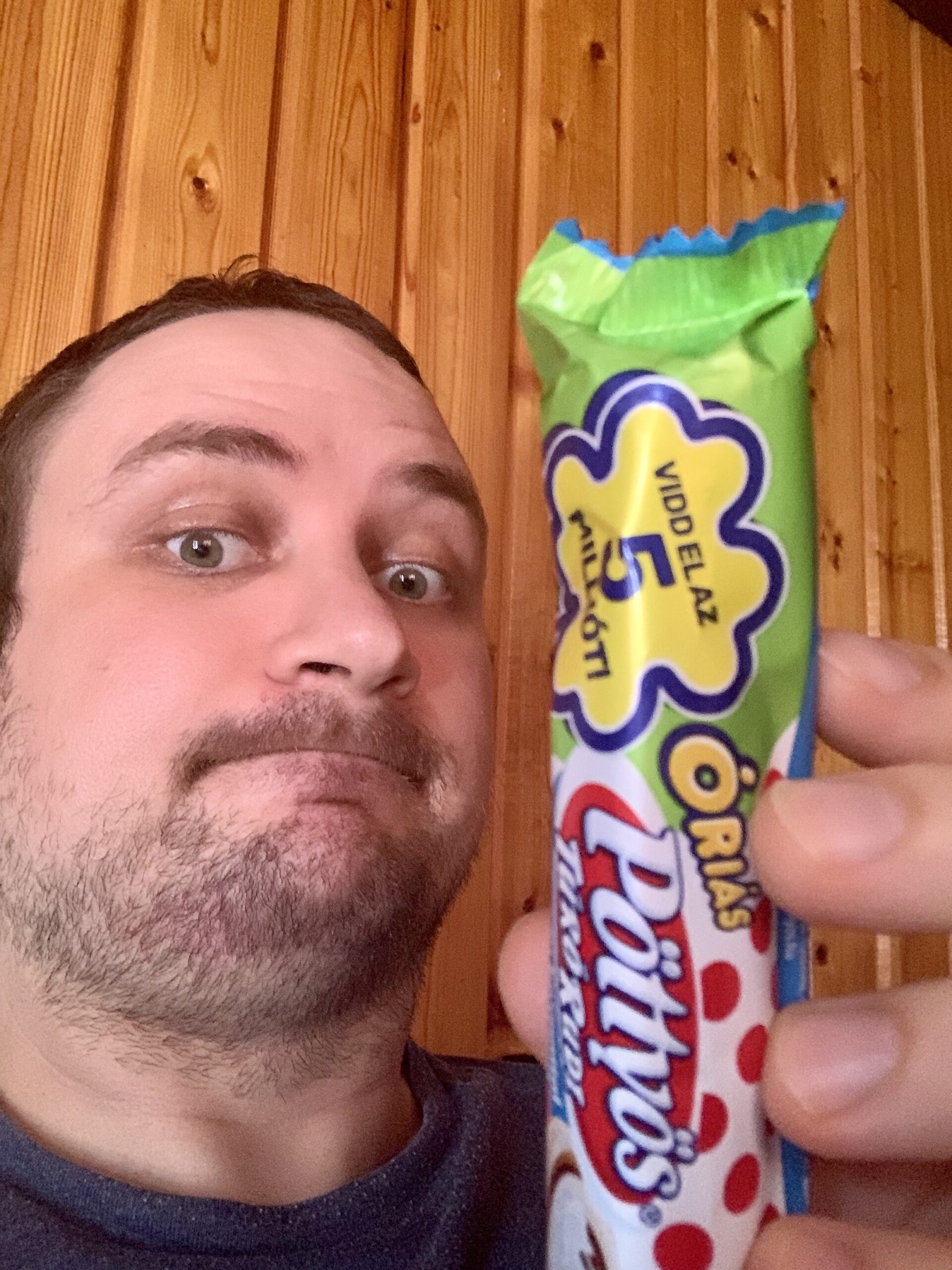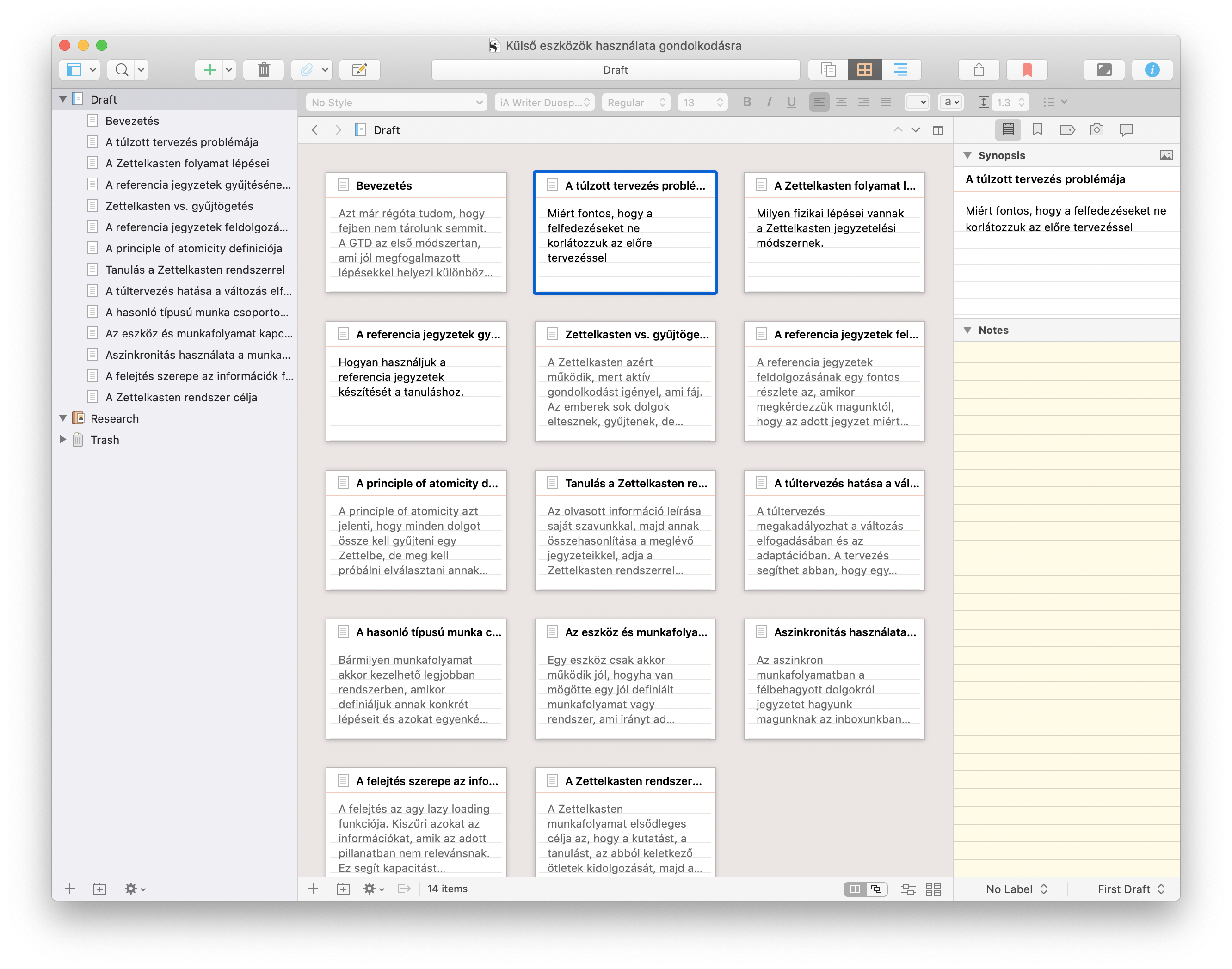Pár hét bokaszalag szakadásos gipszben fetrengés után a mai első fizikai sikerélményem, hogy ide tudtam magamnak hozni egy Túró Rudit a hűtőből.

Pár hét bokaszalag szakadásos gipszben fetrengés után a mai első fizikai sikerélményem, hogy ide tudtam magamnak hozni egy Túró Rudit a hűtőből.

Ha az AgileBits minden platformra meg tudja csinálni rendesen a natív 1Passwordöt (még Linuxra is), akkor semmi kifogása nincs a többi 10x akkora cégnek arra, hogy Electronos szutykokat toljon az arcunkba.
Elég szomorú, hogy sok magyar blogger, akiket 2005–2010 környékén olvasgattam teljesen eltűntek, vagy csak szimpla Twitter retweetgépekké redukálódtak.
Válasz erre: :
Az előző login UX poszthoz még ezt a cikket tudom linkelni, mint kiegészítés.
Mondja már el valaki nekem egyszerű halandónak, hogy miért jó az login közben, hogy először elkéri az oldal e-mail címem, majd gombot nyomok és aztán új oldalon a jelszavamat?
Az utóbbi évek legnagyobb UX-es faszsága.
Nagyon ismerős jelenség.
/via @ern0plus4
Előzmények: Ágyban fekve és Még mindig ágyban fekve
Ma voltunk újabb kontrollon a dokinál.
3 hete fekszek, a lábam felpolcolva. Szerencsére javul a dolog, de még mindig annyira fel dagadva a lábam, hogy nem raktak rá se járógipszet, se bokasínt.
Csináltak egy ultrahangot is ma a bokámról. Teljes ínszalagszakadás, eddig azt hittük csak részleges. Visszatették a pihenős gipszet, majd 2 hét múlva kontrollra vissza kell mennem. A doki szerint nem kell beszarnom, meg fog gyógyulni csak lassabban, mint gondolták. Reménykedek is benne, mert azzal már riogattak páran, hogy a teljes szakadást műteni szokták – igaz Dr. Google mást ír erről – viszont ennyi hét fekvés után egy műtéthez abszolút semmi kedvem (nem mintha egyébként lenne).
Dolgozni szerencsére tudok, igaz takaréklángon, mivel a laptop az ölemben van és a gépelés nehézkes — a cégnél szerencsére mindenki megértő. Legalább valamivel lefoglalom magamat. Egyedül a hátam és a nyakam kezdi feladni, úgyhogy több szünetet kell tartanom. Fürdeni még mindig nem tudok egyedül, Rami segít benne, aki azóta a személyes hősöm lett. Nagyon hálás vagyok neki, mert nélküle nem tudom mi lenne.
Egyelőre ennyi, 2 hét múlva újra jelentkezek…
A MacStories összeszedte azokat információkat amiket a Mac Catalyst 2.0-ról tudunk:
WWDC 2020 was different. Apple introduced what was effectively Mac Catalyst 2.0 with its Optimized for Mac initiative, a separate Mac Catalyst path that follows Mac conventions more closely but requires more work. The company also built Messages and Maps, two of its flagship apps, using Mac Catalyst, demonstrating a deeper commitment to the technology than ever before. The result is a brighter future for Mac Catalyst that clearly has a role to play alongside SwiftUI and Apple’s other frameworks.
A lényeg nagyjából az, hogy idén kapott egy új opciót minden iPad alkalmazás arra, hogy tényleges natív macOS UI-t használjon a 77%-os skálázás nélkül. Így a Maps és a Messages, mint két nagy rendszeralkalmazás, tökéletes példája lesz az új Catalyst API-k tudásának.
Sajnos a Mapsből eltűnt közben a letéphető popover funkció, a Messagesből pedig az AppleScript támogatás, ami az előző AppKit alapú, iChatből lefaragott kliens még tartalmazott. Nem tudom mennyire van ilyen funkciókra manapság igény, viszont visszanézve azt a rendszerintegrációt, amit annakidején az iChat tudott, sajnos a Messages közelében sincs jelenleg ennek – igaz az app is kevesebbet tud.
Nem szeretném, ha az új többplatformos, natív alkalmazásokból eltűnnének azok a Mac-only apróságok, amik 2006 végén az Apple platformokra csábítottak.
Visszatettem tegnap este az iOS 13-at. Pár nap használat után azt mondom, hogy meglepően stabil, különösebb problémám nem volt vele. Remélem ez őszig így is marad és elkerüljük a tavalyi problémás release-eket.
Egyelőre viszont nagyon hiányzik, hogy a 3rd party appok még nem támogatják az új rendszerfunkciókat.
A Reminders használatára tett kísérletem úgy omlott össze használat közben, mint a kártyavár, úgyhogy visszanyargaltam OmniFocusra 2 nap után. Nem hiába érzem a használata közben, hogy nekem ez a trusted system, mindenesetre nagyon várom már az OmniFocus widgeteket.
Egy valamit nem értek. Mi az isten csíkos f*$záért kellett kiszedni az iOS 14-ből a 3D Touchot és lecserélni Haptic Touchra, ha tudja a hardver? Nagyon nem ugyanaz a kettő és hiányzik a 3D Touch.
Már régóta idegesített, hogy az iOS-en oly sokat használt Site Search shortcutomnak nincs macOS megfelelője, úgyhogy ma reggel összeraktam Automatorben. Mindössze annyit csinál a cucc, hogy adott weblapon elindítva megkérdezi mire szeretnék rákeresni, majd megnyitja a Google találatokat egy új Safari tabon az adott oldalról.
Az iOS 14 alatt újra megpróbálom használni a Reminderst az OmniFocus helyett. Egész pofás kis UI-t adtak az emlékeztetők szerkesztésére, az ikonok nagyon jól kiemelik a különböző szekciókat.

Ami viszont nagyon szexi lehet a GTD-vel integrált Reminders workflowban, az a lista widget, amivel lényegében kipakolhatom az összes következő lépések listámat közvetlenül a home screenre.
Az egyik, amivel mindig problémám van, a telefonhívások, üzenetküldések és e-mailek lista, amit hozzáadtam az első oldal tetején levő Smart Stack widgethez. Így azonnal látom miket kell(ene) a telefonomon csinálnom az adott pillanatban.

A másik egy dedikált home screen a következő lépésekre. A Reminders lista widgetje kis méretben csak az első tennivalót mutatja a különböző kontextus listámról, így azonnal kapok egy átfogó képet arról, hogy melyik kontextusban mit tudok csinálni.

Nem fogom feltenni az iOS 14 bétát. Nem fogom feltenni az iOS 14 bétát. Nem fogom feltenni az iOS 14 bétát. Aztán végülis feltettem az iOS 14 bétát, ami meglepően stabil idén. Viszont azt nem értem, hogy az iPadOS miért nem kapta meg az App Library és Home Screen widgetek funkciókat.
Nem hallgattam még meg a Tankcsapda új számát. Nem azért mert nem volt rá időm, hanem mert I don’t give a fuck.
Előzmények: Ágyban fekve
Nos, elvileg csütörtökön leszedik a lábamról a gipszet, amit már alig várok. Nagyon szar a gipsz. Kemény, fáj benne a lábam, aludni sem lehet tőle rendesen, ráadásul amikor mankóval jár az ember, akkor piszok nagy plusz súlyt jelent a fájó bokának.
Tegnap egyébként már egész jól voltam, viszont ma reggel megint úgy keltem, hogy úgy fáj, mint 2 nappal ezelőtt. Lassan a végére érek az első levél fájdalomcsillapítónak. Az éjszaka valahogy rosszul tarthattam a lábamat, mert reggel olyan volt, mintha az összes irányból fájna minden ínszalag. Napközben egy picit enyhült, de elég szar ahhoz képest, hogy tegnap már egész tűrhető volt.
A fürdés hihetetlen szívás. Mivel a gipszet víz nem érheti, így most egy kukászsákot szoktam kötni arra a lábamra, amíg “zuhanyzok”. A részletekbe nem mennék bele, de ha véletlenül ilyen helyzetbe kerülsz, akkor egy szék hasznos lehet a fürdőszobában. A mankóval pedig nagyon óvatosan, piszkosul csúszik a vizes padlón.
Az egész napos fekvés nagyon megviseli a hátamat is. Most már az 5. napot kezdem meg a kanapén hanyatt fekve, a lábamat felpolcova. Néha megemelem és megmozgatom, de egyelőre komolyabb tornát nem tudok csinálni, pedig a neten olvasottak alapján fontos lesz.
Összefoglalva továbbra is szívok, úgyhogy remélem a gipsz levétel és bokasín felrakása után már rohamosabban javulni fogok.
Tegnapelőtt pakolás közben megcsúsztam a lépcsőn és ráestem a jobb bokámra. A sürgősségin megnézték, csináltak röntgent, a doki szerint részleges ínszalag szakadás. Kaptam rá gipszet, mellé mankót és egy hét múlva kell jelentkeznem gipszlevételre, ahol majd átrakják bokasínbe.
Jelenleg annyi dolgom van, hogy egész nap fekszek és pihentetem a bokámat. Ez persze nem olyan egyszerű, tekintve hogy 2 napja nem nagyon mozogtam, kezd fájni a derekam és még a lábam is meg van duzzadva. Próbálok olvasgatni a neten, elővettem régi blogokat amiket újraolvastam, de sok hasznos dolgot eddig nem sikerült kihozni a fekvésből. Jelenleg egy projektem van, hogy gyógyuljak. Szerencsére a feleségem segít mindenben – el nem tudja képzelni milyen hálás vagyok neki, főleg tudva, hogy az egész szarság a költözésünk közepén történt.
A zuhanyzás és az éjszakai WC-re járás hatalmas szívás. Ez utóbbira lehet bevezetem majd a férfiak által használható PET palack pisitartályt. Nem túl gusztusos, de még mindig jobb mint mankóval átkelni a lakásban a WC-ig.
A gyógyulási idő elvileg 6–8 hét, bár már annak is örülnék ha a gipszet bokasínre cserélhetném. Kényelmetlen, nehéz, ráadásul rá se lehet állni – nem mintha amúgy rá tudnék állni arra a lábamra – és még víz se érheti. A lényeg hogy ilyenkor újraértékeli az ember az olyan hétköznapi dolgokat, mint a járás és az alapdolgok segítség nélküli elvégzése.
Egyelőre ennyi, pár nap múlva írok, hogy mi történt.
Megint előkerült az “Apple touch screen Maceken” dolgozik mém, mivel a Big Surben néhol nagyobb a padding a gombok körül. Ilyenkor csak eszembe jut, hogy biztos akarunk mi touch screen Maceket? Lásd az alábbi iPades illusztrációt…

A Sandwich Video úgy néz ki tudott adaptálódni a COVID-19 helyzethez úgy, hogy korábban a remote munkát említve nevettek volna. Kíváncsi vagyok hosszútávon hasonló helyzetben lévő cégek hogyan fognak nyerni vagy veszíteni ezzel a járvánnyal.
Miután az új csapatban Slacket használunk kommunikációra, így megint felmerült a hivatalos Electronos kliens, amit nem vagyok hajlandó használni – akkor inkább megnyitom Safariban. Szerencsére most jött velem szembe a Shrugs app, ami egy egész pofás natív Slack kliens Macre.
Ezt a screenshotot pedig csak itt hagyom a poszt végén.

Annak idején nagyon népszerű tartalomfogyasztási forma volt az RSS. Manapság mindenhonnan azt hallom, hogy az RSS egy halott technológia – ami persze baromság – mindenki a social médiát használja. Én is régóta jelen vagyok Twitteren, de az elmúlt 10 év tapasztalata alapján nálam sosem fogja leváltani a social média a feed olvasómat. Sőt, valószínűleg hamarabb fog elhalni nálam a Twitter, mint az RSS.
Elképesztő, hogy ezzel az “attention to detail” tudással hogyan sikerült megrajzolni azt a kotonalakú akkumulátor ikont macOS-en.
Megnéztem a Big Sur bétát. Elsőre sokkal előrébb van, mint az iOS 7 volt, de az ikonok árnyékai miatt valakit seggbe kellene rúgni az Applenél. Az ablakokból hiányzik a kontraszt – sok a fehér — és nem egyértelmű melyik aktív.
Már három napja használom a Magic Keyboardot az iPademmel. Teljes review-t még nem mernék róla írni, de az biztos, hogy must-have eszköz. Most érzem az iPaden azt a híres fun-to-use faktort, amiről annyi iPad Pro felhasználó beszél mindig.

Próbálom kideríteni hogy vajon túlvállalt vagyok-e vagy átlagos, erről akarok feedbacket gyűjteni: kiváncsi lennék hogy ki hány ügyfelet, munkát, hobbit menedzsel/csinál egyszerre?
Olvasói jegyzetek a “How to Read a Book: The Ultimate Guide by Mortimer Adler” című bejegyzésből.
Az olvasásnak két célja létezik: amikor azért olvasunk, hogy megértsünk valamit, vagy azért hogy információt szerezzünk. Az első nehéz, a második könnyű.
Mortimer Adler négyféle olvasási módot különböztet meg.
Az összehasonlító olvasás öt támpontja:
Befejeztem a napokban Sönke Ahrens – How to Take Smart Notes c. könyvét, ami legalább annyira fontos a mentális munkával foglalkozó emberek számára, mint a Getting Things Done könyv David Allentől.
A lényege számomra az volt, hogy felismertem mennyire fontos a külső eszközök használata a gondolkodásunk támogatásához, felszabadítva az agyunk kreatív kapacitásait. A másik big takeaway pedig, hogy mennyire fontos definiálni, szeparálni, majd rutinként beilleszteni egy munkafolyamat különböző lépéseit. Így kézzelfoghatóbbá válik minden bonyolult dolog.
Két jegyzet a könyvből:
Elkezdtem összegyűjteni és kiválogatni a jegyzeteimet a külső eszközök és a gondolkodás kapcsolatára. A későbbiekben ebből tervezek majd kitenni ide is egy hosszabb blogposztot.

Bármilyen munkafolyamat akkor kezelhető legjobban rendszerben, amikor definiáljuk annak konkrét lépéseit és azokat egyenként egy adagban végezzük el (batching). Ezzel elkerüljük azt, hogy egy folyamatban a különböző lépésekhez szükséges különböző figyelmi igények és kognitív funkciók összekeveredjenek. Amikor egy menetben csináljuk a különböző lépéseket, akkor lényegében multitaszkolunk. Ilyenkor viszont nem több dolgon dolgozunk egyszerre, hanem csak gyakran váltogatjuk a figyelmünket. Ez lényegesen csökkenti a hatékonyságunkat.
Az a legjobb, ha átgondoljuk a folyamatot, megkeressük benne a hasonló figyelmet igénylő lépéseket, majd azokat egyben végezzük el, lehetőleg elkerülve azt, hogy a különböző lépések egyszerre elvégezve multitaszkoljunk.